|
1.
CENTRAL/ WEST AFRICA
Prices fluctuate as low trade hits producers
The downturn in trade has now started to impact West
African prices, with some significant price decreases
occurring even for the more popular species. Gabon¡¯s
harvesting ban on four timber species (douka/makore,
moabi, ozigo and afo) has not had any notable effect due
to the large overstock of moabi and douka/makore in
major markets and low demand from the construction
industry. Prices were up about EUR30 m³ for both logs
and lumber, with the expectation buyers will want to take
advantage of log stocks being disposed by producers until
the end of March. The forestry department in Gabon is on
strike, with the expected cause being over certain elements
of the pay package for staff. In the region many forest
operators and sawmills are closed, and some closures
continue to be made.
It is a buyer¡¯s market and companies in operation are
facing very tough negotiations on price. India and China
are still buying and Vietnam is also still very active and
steadily increasing import volumes. Log production in
Congo Brazzaville is low. Trade with South Africa has
slowed after a very long period of regular, high volume
intake of West African sawnwood species. Buyers in
possession of contracts are asking exporters to hold
shipments for unspecified later dates.
Exporters and traders report that pricing has become very
difficult and finding a base price level has not been easy to
determine. Sapele sawn stocks are now much depleted and
prices for remaining stock depend very largely on what the
buyer will offer, new production is low and prices tend to
be firm for buyers¡¯ specifications. Sipo has firmed up
again because of limited production.
Price negotiations for okoume logs are affected by the low
plywood consumption in European markets. In particular,
the slow down in imports and the reduced prices of
plywood from China reflect back to plywood
manufacturing in other countries, squeezing margins and
resulting in lower offer prices for the raw materials.
DRC cancels nearly 60% of timber contracts
After a review of 156 logging deals in the Democratic
Republic of Congo (DRC), the government has cancelled
nearly 60% of timber contracts in the country¡¯s rainforests,
reported the BBC. The investigations, backed by the
World Bank, were conducted with the view to exposing
corruption and enforcing environmental standards. The
investigations concluded that only 65 of the existing deals
were viable. The government notified the relevant
companies of the cancelled contracts and indicated new
contracts would be issued for 90,000 square kilometers of
forest area.
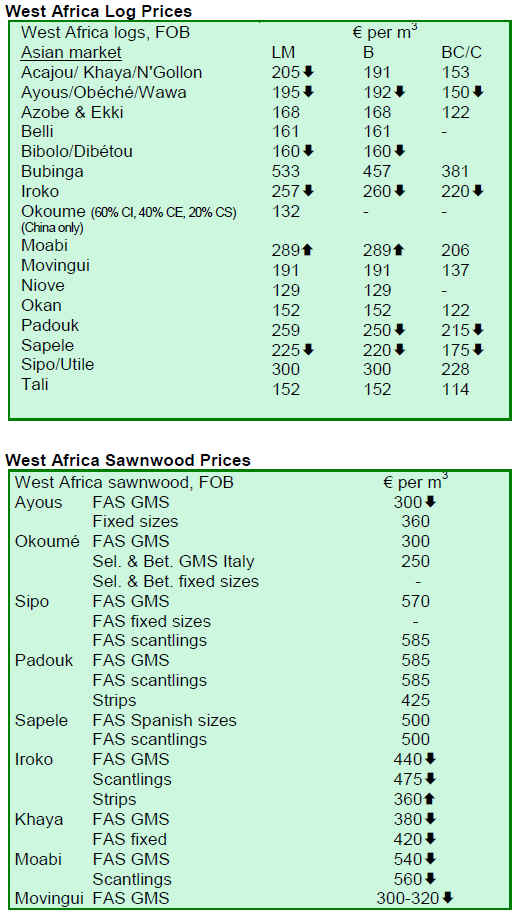
2. GHANA
Export contracts drop in third quarter 2008
A total export contract volume of 169,481 m³ was
processed and approved during the third quarter of 2008,
according to Ghana¡¯s Timber Industry Development
Division (TIDD). This represents a decrease of 13.6%
compared to the figure for the second quarter of 2008. In
a similar development, furniture parts processed and
approved during the quarter under review were 15,379
pieces, an increase of 28.7% compared to the figure for the
second quarter of the same year.
With the exception of lumber and logs/billets/poles, which
increased 2.5% and 16.7% by volume to register 54,326
m³ and 47,274 m³, respectively, almost all exportable
products decreased by volume during the third quarter
2008.
While plywood contracts decreased 32.6%, amounting to
45,083 m³, sliced veneer, rotary veneer,
moldings/processed lumber and finger jointed lumber
decreased by 36.3%, 20.9%, 37.7% and 57.7%,
respectively, to register volumes of 8,690 m³, 5,189 m³,
4,180 m³ and 2,340 m³.
Lumber regained its position as the leading exported
product, contributing 32% of the total volume achieved
during the quarter under review.
John Bitar Company Ltd (JCM), A. G. Timbers Ltd. and
Rimmens Company Ltd. secured three free permits, issued
in Takoradi, for the shipment of 312 pieces of wood
carvings and various wooden musical instruments.
Compared with the previous quarter, only one (1) free
permit was issued for the shipment of wood carvings to
Italy.
One special permit was issued in Takoradi to Machined
Wood Company Ltd. for the shipment of sapele laminated
strips to the UK. This shipment involved a total volume of
11,367 m³ and a total value of EUR13,072. These
laminated strips were made from sapele sawn timber,
which were imported from Gabon. However, no special
permit was issued during the second quarter of 2008.
In another development, 53 export permits were issued in
Takoradi to several companies for the shipment of teak
billets, poles and logs to India and Hong Kong, while 157
export permits were issued in Tema for the shipment of
teak billets, poles and logs to India and Vietnam. These
shipments involved a total volume of 29,011 m³ and a
corresponding total value of EUR5.88 million. From these
shipments, an amount of EUR587,679 was the export levy
on unprocessed timber, as stipulated under the Trees and
Timber (Amendment) Act, 1994 (Act 493).
Other export permits issued in Takoradi during the quarter
were 12 export permits for the shipment of gmelina billets
and poles to India. These involved a total volume of 2,298
m³ and a corresponding total value of EUR215,867. Two
export permits to Best Glow Wood Ltd. were issued for
the shipment of rubberwood lumber to Malaysia, for a
total volume of 125 m³ with a corresponding value of
EUR14,618. Eight export permits were also issued to John
Bitar Company Ltd. (JCM) for the export of blockboard
and plywood by road to Nigeria, in the amount of 185 m³
(EUR59,559).
Five (5) export permits were issued in Tema to Messrs.
Danteng Wood Processing Company Ltd. and Geavag
Company Ltd. for the shipment of rosewood (Pterocarpus
erinaceus) lumber to China, India and Thailand. These
shipments involved a total volume of 166 m³ and valued at
EUR44,699.
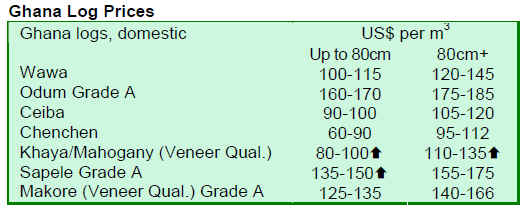
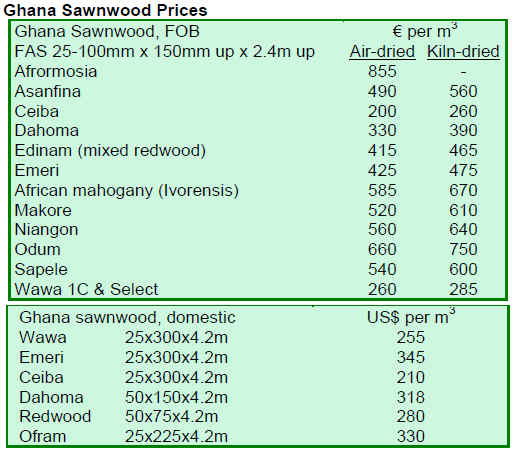
3.
MALAYSIA
Decline in timber business expected after Chinese New Year
Malaysian prices continued to decline as the global
economic slowdown continued. BTimes indicated that the
price decline was further aggravated by the worst slump in
US lumber prices in almost 18 years and shares of
Malaysian timber companies were equally negatively
affected. However, the full impact of the drop in prices
was paused due to the closure of businesses during the
annual Chinese Lunar New Year celebrations.
Nevertheless, the decline in prices is expected to persist
after the New Year festivities.
Low growth of GDP anticipated in 2009
Analysts expected Malaysia¡¯s GDP growth to be between
1.1% and 2.2% in 2009 as the national economy contracts,
reported Bernama News. Unemployment is expected to hit
4.7% and market conditions continue to be bleak. The
Malaysian Ringitt fell for the third week in the wake of
speculations that the central bank will cut interest rates to
stimulate economic growth and aid local exporters.
DRC cancelled contracts could provide Malaysia with opportunity
The Independent reported on traders¡¯ hopes that Malaysian
sawnwood suppliers can fill the void created by the
cancelled contracts in the Democratic Republic of Congo
(see West/Central Africa section). However, the EU, one
of the major destinations for timber from the DRC may
prove to be elusive for Malaysian timber suppliers as EU
shares fell to a six-year low, according to The Guardian.
Economic data indicated the UK economy went into
recession at the end of 2008 and contracted 1.5% in the
fourth quarter of 2008.
Government decides to reduce export of natural rubber
Btimes reported on Malaysia¡¯s decision to reduce the
export of natural rubber by 5% to 57,050 tons in year
2009. As a result of this measure, more rubber plantations
can be replanted or converted into alternative commercial
projects. This would mean that more rubberwood would
be available as raw material, thus reducing pressure on
rubberwood prices.

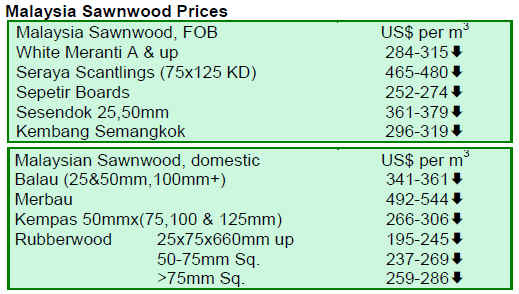
4.
INDONESIA
Domestic prices of Indonesian wood products plunge
The current economic climate in Indonesia is pushing
domestic prices of Indonesian wood products near the
verge of collapse. With the country grappling with
unemployment, there is a fear that more natural forests
will be cleared for agricultural purposes as the country
struggles to contain rising poverty. Some Indonesian
plywood manufacturers have been unable to fulfill their
order books beyond April 2009. Orders from the U.S. have
stalled while Japanese buyers are making some of the
smallest orders ever witnessed by Indonesian plywood
manufacturers in 20 years. Buyers from the Middle East
are seeking discounts for purchases to complete ongoing
projects. Some manufacturers are considering the
possibility of cutting production by reducing the number
of working days between three to four days per week in
order to stay afloat.
Forestry Minister optimistic about plans to eradicate illegal logging
Indonesian Forestry Minister M.S. Kaban¡¯s recently stated
his optimism on Indonesia¡¯s five programmes to eradicate
illegal logging and trading in state forests, revitalize
forestry, conserve and rehabilitate forest resources,
employ people living inside and around forest areas, and
consolidate forests, reported Antara News. He added that
Indonesia faced a two-pronged problem with
deforestation, due to the high and irreversible rates of
deforestation experienced by Indonesia from 1997 until
2000 and the current state of degraded forests, estimated at
59 million hectares.
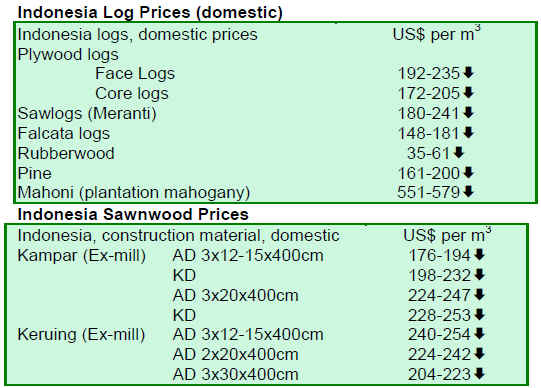
5.
MYANMAR
Bleak outlook for Myanmar timber
Bids from major buyers have propped up prices of teak at
last week¡¯s tender, although average monthly prices
steadied. The quantity of teak was also adequate for the
amount of bids made. Most analysts say the market is
moving very slowly and outlook is a bit bleak for 2009.
The upcoming week¡¯s business will be less active due to
the Chinese New Year Lunar holiday.
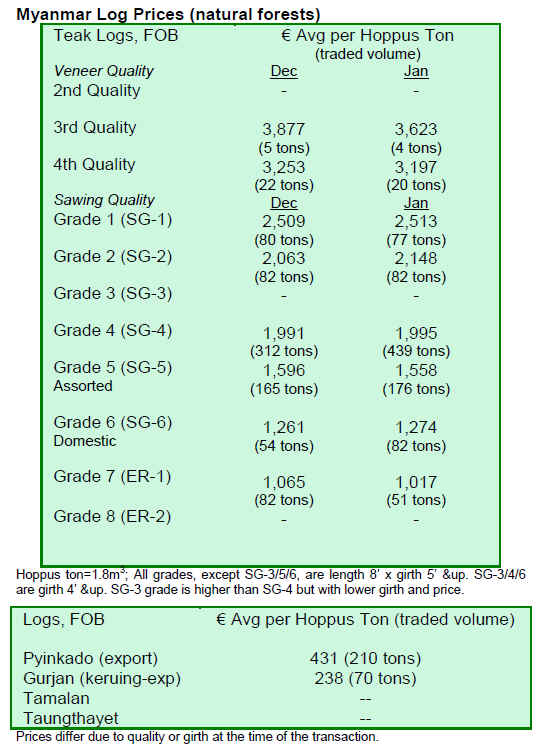
6. BRAZIL
Brazilian Amazon timber sector contributes 3.5% to
GDP
Ag¨ºncia Amazônia reported on how the timber industry in
the Amazon was the largest industrial employer. Although
the Amazon timber industry was the largest industrial
employer and collected the highest amount of taxes, it was
said to be responsible for a deforested area of 11,986 km²
in 2007. Nevertheless, the sustained performance of the
sector made Brazil one of the world¡¯s top producers of
tropical timber.
In 2004, the timber sector generated 124,000 direct and
108,000 indirect jobs, with over 147,000 jobs located
outside the region. Timber activities also provided a gross
income of USD2.3 billion, involving 3,132 companies
distributed in 82 timber clusters. The export value of
products from the industry also jumped between 1998 and
2004, from USD381 million to USD943 million,
according to the results of the Sustainable Action Plan
(PAS).
The parts of the production chain directly dependent on
timber accounted for 3.5% of Brazil¡¯s GDP and 6% of
exports in 2006. In the same year, the industry collected
more than BRL4.2 billion in taxes and generated 6 million
direct and indirect jobs in the country. The activity is
spurred by complementary activities in other industrial
sectors of the economy: the steel industry; the pulp and
paper industry and the civil construction industry.
Timber sales, price and stock of timber drops in Northern Mato Grosso
The municipality of Sinop has seen slowing business for
timber companies in 2009. Demand has been low since
mid-December and the majority of companies have also
held a low volume of timber stocks. The timber industry is
the economic base for the many cities in the Northern
region of the country. In Sinop alone, there are over 150
timber-related companies.
According to the Union of Timber Industries of Northern
Mato Grosso (SINDUSMAD), many companies are short
of timber for sale due to delays associated with the State¡¯s
approval of forest management plans for selective logging.
Another factor is that few companies are able to harvest in
the rainy season. However, since sales are currently low,
no shortages of timber in the market are anticipated.
SINDUSMAD noted a drop in timber prices between 10
and 15% during the last quarter of 2008, depending on the
species. However, sales are expected to grow from
February 2009 and the current state of the market seems
suitable for exports. Currently, with a more favorable
exchange rate, exports of timber products are expected to
grow, although accurate forecasts have not been made.
Another positive expectation relates to the validity of
forest management plans, for a period of five years,
instead of being reviewed annually.
Brazil¡¯s November and December 2008 exports fall from October levels
Brazil¡¯s wood products exports (except pulp and paper) in
the month of November 2008 slipped from November
2007 levels, decreasing in value by 45.7%. The largest
year-on-year fall in exports by value was in pine
sawnwood products. The charts below show the volume
and value of Brazil¡¯s exports for November 2008
compared to the same month a year earlier:

In December 2008, solidwood exports dropped 33.2%
compared to the previous year¡¯s levels. The value of all
other wood exports, with the exception of wood furniture,
fell by value during the month of December 2008. The
charts below show the volume and value of Brazil¡¯s
exports for December 2008 compared to the same month a
year earlier:
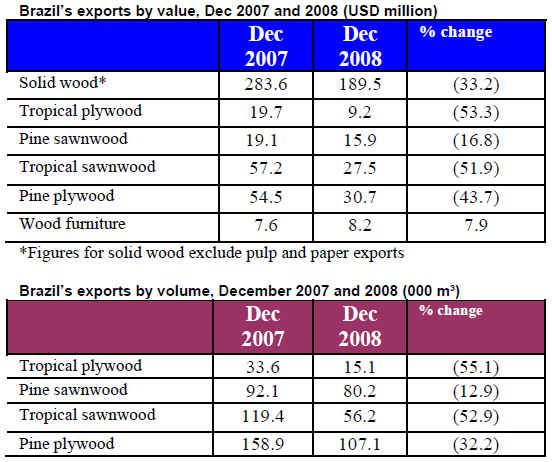
US furniture imports from Brazil tumble 35%
Gazeta de Bento Goncalves reported on the recent drop in
US furniture imports from Brazil. Despite a drop of 30%,
the US, which imports 16% of Brazil¡¯s furniture, is still
the largest importer. The US is followed by Argentina,
France and the UK as the main markets for Brazilian
furniture. France imported 12% more furniture from
January to November 2008 compared to the same period
in 2007. In contrast, the UK imported 7% less in 2008. A
notable trend was a growth in Africa¡¯s imports of
Brazilian furniture, which grew 64% in 2008. Angola is
one of the largest importers of Brazilian furniture,
matching the UK¡¯s import share of 7%. At the intraregional
level, Argentina accounted for 13% of total
exports, raising imports by 46% from January to
November 2008.
The furniture industry of Rio Grande do Sul announced
domestic sales of 29% during the first 11 months of 2008
and a growth of 1.9% in exports. The state remains behind
Santa Catarina as the largest exporting state in Brazil, with
Santa Catarina accounted for 32% of exports in 2008. Sao
Paulo saw a 28.5% growth in its exports compared to 2007
levels.
Export situation worsens in Par¨¢
The global financial crisis is affecting exports from the
Brazilian Amazon state of Par¨¢, reported Folha da Mata
Online (No 71). Exports of manufactured and
industrialized wood products from Par¨¢ dropped 19% by
value and 35% by volume from January to November
2008 compared to the same period in 2007. The largest
drops in exports were recorded in painting and photo
frames, particleboard, plywood and veneer. According to
the Timber Exporting Companies Association of Par¨¢
(AIMEX), the forest sector was beginning to feel the
effects of the crisis, which were exacerbated by factors
such as a reduction in raw material supply and the falling
value of the US dollar in the second half of 2008. Since
August 2008, the situation has become worse. Despite the
appreciation of the US dollar against the Brazilian real,
demand for wood products from Par¨¢ by importing
countries has dropped, including in US and EU countries,
the main importers of Brazilian wood products.
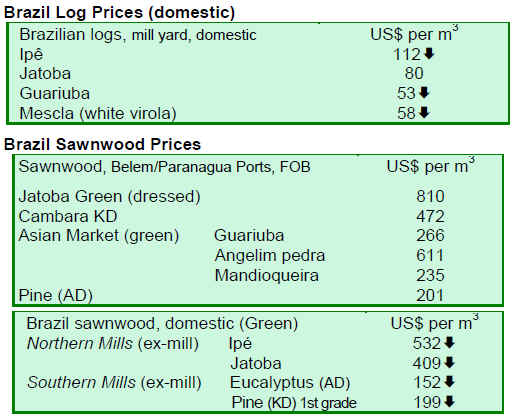
7.
PERU
Peru ¨C US sign FTA
On 16 January 2009, Peru signed a Free Trade Agreement
(FTA) with the US, reported various news sources. The
agreement, which will take effect from 1 February 2009,
opened possibilities for Peru¡¯s intellectual property
arrangements, said Peru¡¯s Minister of Tourism and
Foreign Commerce, Mercedes Araoz. Some also expected
the agreement to reflect improved environmental
standards. However, the BBC reported that the agreement
had been criticized for putting the Amazon rainforest at
risk and had not strengthened labor rights.
Sales of Peruvian wood products fall in China
Mauro Rios Torres, a forest expert in Peru, warned that
China¡¯s wood intermediaries were being increasingly
indecisive about buying more wood from Peru. There was
significant overstocking in the Asian market, since wood
products from China¡¯s markets were being redirected for
internal consumption instead of being sold to key
exporters, the US and EU. He said Chinese buyers were
not purchasing hardwoods or flooring from Pucallpa and
Puerto Maldonado producers, with as many as twenty
producers in these areas losing sales to China. Producers
from the regions were mainly shipping small volumes of
products to the Chinese market. Since last September,
wood prices had fallen, with China reducing its demand by
more than 50% for wood flooring. The US had stopped
importing sawnwood made from mahogany and Spanish
cedar, as well as other furniture and manufactured
products. The effects were particularly being felt in Lima
and Pucallpa.
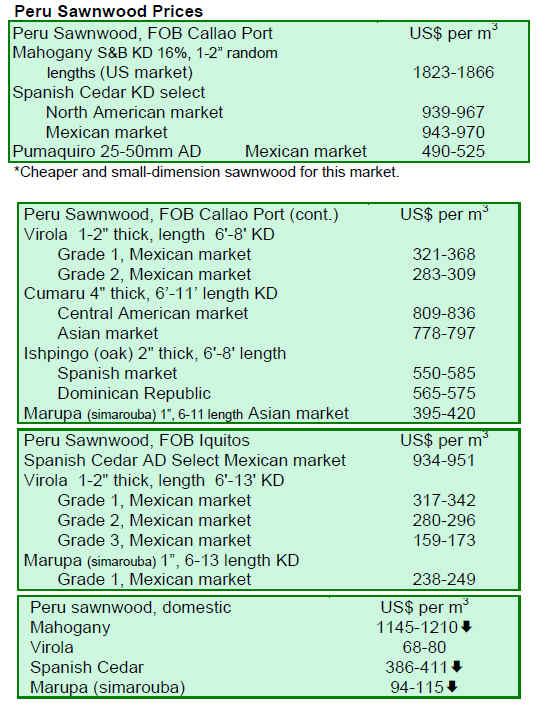
U
8. BOLIVIA
Forest products exports from Santa Cruz and La Paz
drop
Exports from Santa Cruz showed an approximate 15%
drop in exports from January to December 2008,
compared to the same period in 2007, falling in value from
USD63 million to USD53.4 million. Similar trends were
seen in La Paz, where forest products exports contracted
nearly 10% in value, from USD51.6 million to USD46.4
million, bucking a positive trend since 2002. The reasons
for the falling trends were political uncertainty in the
country, lack of adequate fuel distribution, the devaluation
of the dollar, and the financial crisis, particularly affecting
the US and parts of Europe.
Exports of wooden manufactured products were valued at
USD66.1 million in 2008, consisting mainly of three-ply
panels, doors, fiberboard, furniture and parts and chestnut
without shells. The remaining USD33.8 million of
Bolivian wood exports from the two regions were from
semi-processed products, including sawnwood, wooden
sticks, and poles. Exports of wooden products accounted
for 85% of total Bolivian exports, while non-wood
products made up about 15% of exports.
Caviuna, alemdrillo, oak, ipe and curupau were in the
highest demand in foreign markets, generating USD11.3,
USD9.3, USD7.8 and USD7 million, respectively. As with
the previous year, 61 species were represented in the wood
exports of Bolivia. The US, even in the financial crisis,
remained the main buyer of Bolivian wood products worth
USD29.8 million. China imported USD9.4 million,
Argentina USD6.9 million and the UK and France USD6
million each. A total of 53 countries purchased products
from Bolivia, three less than 2007.

9.
Guyana
Early 2009 brings strong results for Guyana
Export market prices showed strong results at the start of
2009 with recorded increases in average prices for
sawnwood, roundwood, splitwood and plywood compared
to 2008 prices for same period. Improvements in average
prices were greatest for splitwood, with prices rising by
30%. This was closely followed by gains for sawnwood
and plywood, with increases in average prices reaching
29% and 28%, respectively. Other improvements were
recorded in average prices of roundwood, which showed a
13% rise compared to the same period of 2008.
In terms of destination, Guyana¡¯s forest products were
exported mainly to Latin American/Caribbean markets.
Favored products for these markets included sawnwood
roundwood, splitwood, plywood and other value added
products such as crabwood doors and spindles made from
greenheart, purpleheart, kabukalli and wamara. Other
markets for Guyana¡¯s forest products were in North
America, Asia Pacific and South America, with the latter
two¡¯s interests being only in shingles and plywood
respectively, while North American market interests were
in sawnwood, splitwood and wooden utensils and
ornaments.
In other news, no logs were exported for the first fortnight
of 2009, largely due to the new log export policy that took
effect on 1 January 2009, which imposes a higher export
commission on certain species of logs, and to a lesser
extent, to the early closure of operations by many
concessionaires as a consequence of rainy weather at the
end of 2008. In the corresponding period for 2008,
Guyana¡¯s log export volume total was 4,989 m³. On the
production side, reports from one large concessionaire also
indicate that 2009 promises to be more rewarding, with
hopes pinned on earlier starts in operations and plans
being made for greater efficiency in their production
processes.
Guyana unanimously passes new Forestry Bill passes with unanimous support
Guyana¡¯s Forest Bill 2007 (Bill No. 21 of 2007), which
seeks to consolidate and amend the law relating to forests,
was unanimously passed by Parliament on 22 January
2009, with strong support from both government and
opposition members of Parliament. The Forest Bill 2007
provides an important and timely piece of legislation
necessary to ensure that Guyana¡¯s forest sector continues
to contribute to the country¡¯s sustainable development.
The Bill was the product of a lengthy public consultation
with various stakeholder groups including Amerindian
NGOs, the Forest Products Association, Guyana
Manufacturing Association, civil society groups, and even
a number of international organizations. The Bill was
introduced in the National Assembly and read for the first
time on 2 August 2007. Following its first reading, the Bill
was committed by the National Assembly for
consideration by a Special Select Committee, with the
Committee meeting on fifteen (15) occasions during the
period 15 January 2008 to 13 January 2009. On 22 January
2009, members of Parliament supported and unanimously
accepted the passage of the Bill.
The Bill takes into account the important contribution and
role played by Guyana¡¯s forest resources in climate
change mitigation and the provision of environmental
services. It also seeks to update existing legislation under
which forests are managed with keen regard to
international best practices for sustainable forest
management and legality. The Forest Bill also recognizes
forests¡¯ vital role in poverty alleviation especially in
relation to forest dependent communities.
The Bill sets a regime for the sustainable management of
the state forests. The second part of the Bill provides for
the issuance of five types of state forest authorizations:
concessions, exploratory permits, use permits, community
forest management agreements and afforestation
agreements. This section also addresses compliance with
occupational health. The Bill prohibits acts that could
cause forest fires in State Forest areas and allows the GFC
to declare certain areas to be fire protection areas. The
Bill places emphasis on value added activities by
addressing issues of quality control through legally
binding codes of practice which can be subject to
amendments from time to time. Issues of under-pricing,
unlawful exportation of forest produce, trade of timber in
contravention to the GFC¡¯s guidelines, and procedures for
ownership of concession areas and change thereof, are also
outlined in the Bill.
This Bill will serve to significantly enhance the quality of
environmental management, the contribution of the forest
sector to Guyana, and the benefits derived for forest-based
communities and surrounding areas.
Growing interest in RIL and SFM stimulates demand for training
The Guyana Forestry Commission and the Forestry
Training Centre Incorporated (FTCI) planned a one-day
course in Georgetown on 31 January 2009 for decision
makers of forest enterprises and public agencies. Given the
high level of interest, another course will be held on 7
February 2009 with similar courses being planned for the
country¡¯s regions 2 and 6 in February 2009.
FTCI normally offers a three-day ¡®Decision Makers¡¯
Course¡¯ at its field centre, where senior staff of forest
enterprises, public agencies, environmental NGOs and
communities have a chance to observe a model logging
operation, review RIL practices, and discuss the skills sets
required for a well planned logging operation. A quick
look at the profile of persons registering for the course
reveal interest by senior staff of GFC, chairpersons of
communities, senior staff of forest enterprises and
environmental NGOs and lecturers in forestry.
The course will include a review of emerging
developments in the forestry sector, the legislative
framework for forestry practices, forest management
planning, RIL concepts and practices, occupational health
and safety, considerations on the use of machines and
forest roads, management of timber quality and
management of costs.

uyana
|